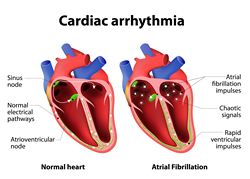Origin of heart arrhythmia
Transcription factors (TFs) regulate cardiac development and electrical function. Previous studies linked development of arrhythmia to mutations in TFs. Hamamy syndrome is a newly described congenital heart disease (CHD) linked to a mutation in Iroquois-class homeodomain protein 5 (IRX5) TF. The main goal of the EU-funded HEART-iPS (Congenital heart disease-associated arrhythmia: deciphering Hamamy syndrome, novel rare disease, using iPS cells) project was the investigation of the role of IRX5 mutation in arrhythmia development. Experimental plan of the project included generation of patient-derived induced pluripotent stem (iPS) cells and transgenic mouse lines. The generated iPS cells were subsequently used for cardiac differentiation and analysis. Researchers then studied cardiomyocytes differentiated from iPS cells generated from two Hamamy patients. Results indicated that the Hamamy mutations in IRX5 did not alter IRX5 expression but caused a loss of functionality. Recorded electrical action potentials from Hamamy derived cardiomyocytes showed a reduction in their action potential duration. Further experiments found that IRX5 probably directly modulates expression of some ion channels, which leads to the reduction of cardiac action potential duration. Additionally, gene expression analysis and chromatin immunoprecipitation demonstrated that IRX5 regulates Connexin 43. This gap junction protein has a crucial role in normal heart development as well as electrical conductivity in cardiomyocytes. Co-immunoprecipitation assays helped researchers identify IRX3 and GATA4 TFs as co-factors of IRX5. In control cardiomyocytes, IRX5 binds to IRX3 and GATA4 to regulate electrical conduction. However, IRX5 with Hamamy mutations sequestered these co-factors in non-functional heterodimers. This means that the mutant IRX5 protein may effect cardiac electrical conduction through a dominant-negative effect on other TFs. HEART-iPS proved the ability of human iPS cell technology to model the functional phenotype of CHD. Overall, this study provided critical insight into fundamental processes involved in the development of cardiac arrhythmias.
Keywords
Heart arrhythmia, stem cell technology, Hamamy syndrome, IRX5, HEART-iPS

